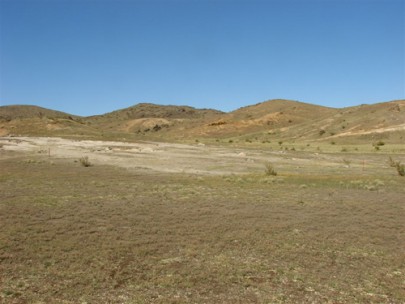Inland saline (salt pans)
In this section
-
Inland & alpine
- Basic cliffs, scarps and tors
- Boulderfields of acidic rocks (non-volcanic)
- Boulderfields of calcareous rocks
- Boulderfields of quartzose rocks
- Braided riverbeds
- Calcareous cliffs, scarps and tors
- Calcareous screes
- Cliffs, scarps and tors of acidic rocks
- Cliffs, scarps and tors of quartzose rocks
- Cloud forests
- Frost hollows
- Granitic gravel fields
- Granitic sand plains
- Inland outwash gravels
- Inland saline (salt pans)
- Inland sand dunes
- Limestone erosion pavements
- Moraines
- Old tephra (>500 years) plains (= frost flats)
- Recent lava flows
- Sandstone erosion pavements
- Screes of acidic rocks
- Strongly leached terraces and plains
- Ultrabasic boulderfields
- Ultrabasic cliffs, scarps and tors
- Ultrabasic hills
- Ultrabasic screes
- Volcanic boulderfields
- Volcanic debris flows or lahars
- Volcanic dunes
- Young tephra plains and hillslopes

Inland saline ecosystem, Galloway, Alexandra Basin (Penny Smale)
Inland saline ecosystems are areas of soil where in the absence of leaching, soluble salts have accumulated to such an extent that they are moderately to highly alkaline (pH > 7). Saline soils accumulate from the weathering of several geological substrates: basement schist, ancient marine or lake sediments, and old alluvial gravels. Because saline soils occur in semi-arid climates where evaporation of soil moisture leads to surface accumulation of salts, they occur patchily across this zone from the mid altitudes of Otago’s block mountains down to basin and valley floors. Surface salts are predominantly a grey-white colour but yellow and pink tinges are frequent. Because the accumulated salts are toxic to most plants, saline soils generally support sparse, mostly herbacerous, vegetation. A range of herbs more characteristic of coastal estuaries and lagoons dominate the limited flora such as Lilaeopsis novae-zelandiae, Oxybasis ambigua, native celery (Apium prostratum subsp. prostratum var. filiforme), Selliera microphylla and Buchanan’s orache (Atriplex buchananii).
Synonyms
Salt pans
Notable flora and fauna
Threatened plants include the nationally critical New Zealand fish-guts plant (Chenopodium detestans), salt-pan cress (Lepidium kirkii), Lepidium solandri, and saltgrass (Puccinellia raroflorens), the nationally endangered Crassula multicaulis, the nationally vulnerable Buchanan’s orache (Atriplex buchananii), New Zealand mousetail (Myosurus minimus subsp. novae-zelandiae) and Myosotis brevis, the declining Oxybasis ambigua, and the naturally uncommom blue wheat grass (Anthosachne aprica), and Cromwell broom (Carmichaelia compacta), .
Threatened lichens include the nationally endangered Buellia epigaea, known only from one inland saline site in Central Otago, and nationally vulnerable Acarospora murorum.
They have a small but distinctive Lepidoptera fauna a species in the genus Loxostege (Crambidae), Paranotoreas fulva (Geometridae) that is restricted to Central Otago and two species, Scythris triatma (Scythrididae) and Kiwaia thyraula (Gelechiidae) that appear to be typical of salt-pans in parts of Central Otago.
Threat status
Critically endangered (Holdaway et al. 2012)
Threats
Most sites have been destroyed by extensive pasture and irrigation development. There are relatively few weeds, but buck's horn plantain (Plantago coronopus) and several barley grasses (Hordeum spp) are serious threats to the relictual native flora on many patches. Many sites are grazed by stock, and rabbits graze on rare plants and erode others with their burrowing. Soil aggregate stability is low and consequently the potential for wind and stormwater erosion is high.
Where do they occur?
Inland saline ecosystems occur in localised areas of Central and northern Otago, particularly in the Lower Manuherikia valley, on the Maniototo Plain, and in the Clutha valley south-west of Alexandra.
Further reading
Allen RB, McIntosh PD 1997. Guidelines for conservation of salt pans in Central Otago. Science for Conservation 49. Wellington, Department of Conservation.
Allen RB, McIntosh PD, Wilson JB 1997. The distribution of plants in relation to pH and saline/alkaline soils in Central Otago, New Zealand. New Zealand Journal of Botany 35: 517-523.
de Lange PJ, Galloway DJ, Blanchon DJ, Knight A, Rolfe JR, Crowcroft GM & Hitchmough R 2012. Conservation status of New Zealand lichens. New Zealand Journal of Botany, 50: 303-363.
McIntosh PD, Beecroft FG, Patrick BH 1990. Register of saline soil sites in North and Central Otago. Volume 1. Technical Record DN5. Division of Land and Soil Sciences, DSIR.
Peat N 1999. Wild Central: Discovering the natural history of Central Otago. Dunedin, Otago University Press. Pp. 52-55.
Peat N 2002. Wild Dunedin: enjoying the natural history of New Zealand's wildlife capital. Dunedin, Otago University Press. Pp. 94-95.
Peat N, Patrick B 2001. Wild rivers: discovering the natural history of the central South Island. Dunedin, University of Otago Press. Pp. 68-70.
Rogers G, Hewitt A, Wilson JB 2000. Ecosystem-based conservation strategy for Central Otago’s saline patches. Science for Conservation 166. Wellington, Department of Conservation.
Rogers G, Overton JM, Price R 2007. Land use effects on "spring annual" herbs in rare non-forest ecosystems of New Zealand. New Zealand Journal of Botany 45:317-327.
Links
Central Otago District Wetlands (Otago Regional Council)
Salt pans (New Zealand Plant Conservation Network)
Salt pan (geology) (Wikipedia)


